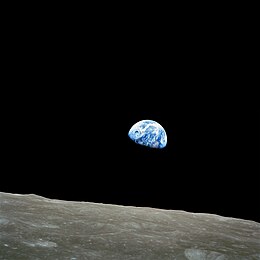Apollo 8
second crewed flight of the United States Apollo program
Apollo 8 was a mission in the Apollo program in December 1968. It was the first crewed spaceflight to leave Earth orbit and first to orbit the Moon. Commander Frank Borman, Pilot Jim Lovell and Bill Anders transmitted a television show while they were in orbit. The Apollo Lunar Module that could land on the Moon had not yet been built, so they went in the Apollo Command/Service Module and photographed and studied the Moon from above. Ten orbits around the Moon took twenty hours. After that, they fired their rockets and returned to Earth.
 | |
| Mission type | Crewed lunar orbiter |
|---|---|
| Operator | NASA |
| COSPAR ID | 1968-118A |
| SATCAT no. | 3626 |
| Mission duration | 6 days, 3 hours, 42 seconds[1] |
| Spacecraft properties | |
| Spacecraft |
|
| Manufacturer | North American Rockwell |
| Launch mass | |
| Landing mass | 4,979 kilograms (10,977 lb) |
| Crew | |
| Crew size | 3 |
| Members | |
| Callsign | Apollo 8 |
| Start of mission | |
| Launch date | December 21, 1968, 12:51:00 UTC |
| Rocket | Saturn V SA-503[n 1] |
| Launch site | Kennedy LC-39A |
| End of mission | |
| Recovered by | USS Yorktown |
| Landing date | December 27, 1968, 15:51:42 UTC[5] |
| Landing site | North Pacific Ocean 8°8′N 165°1′W / 8.133°N 165.017°W[5] |
| Orbital parameters | |
| Perigee | 184.40 kilometers (99.57 nmi) |
| Apogee | 185.18 kilometers (99.99 nmi) |
| Inclination | 32.15 degrees |
| Period | 88.19 minutes |
| Epoch | December 21, 1968, ~13:02 UTC |
| Revolution no. | 2 |
| Lunar orbiter | |
| Spacecraft component | CSM |
| Orbital insertion | December 24, 1968, 9:59:20 UTC[6] |
| Orbital departure | December 25, 1968, 6:10:17 UTC[5] |
| Orbits | 10 |
| Orbit parameters | |
| Periselene | 110.6 kilometers (59.7 nmi) |
| Aposelene | 112.4 kilometers (60.7 nmi) |
| Inclination | 12 degrees |

 Left to right: Lovell, Anders, Borman | |
Related pages
changeNotes
change- ↑ Serial numbers were initially assigned by the Marshall Space Flight Center in the format "SA-5xx" (for Saturn-Apollo). By the time the rockets achieved flight, the Manned Spacecraft Center started using the format "AS-5xx" (for Apollo-Saturn).
References
change- ↑ "Apollo 8". NASA. July 9, 2009. Retrieved November 25, 2018.
- ↑ "Apollo 8 Press Kit" (PDF) (Press kit). NASA. December 15, 1968. pp. 33–34. Release No. 68-208. Retrieved June 28, 2013. – The spacecraft mass at launch includes the CM and SM, but excludes the 4,000 kilograms (8,900 lb) Launch Escape System (LES), which was discarded before reaching Earth orbit.
- ↑ "Pre-Launch Mission Operation Report No. M-932-68-08" (PDF) (Memorandum). NASA. December 17, 1968. p. 30. M-932-68-08. Retrieved February 12, 2019.
- ↑ "Apollo 8 Mission Report" (PDF). NASA. February 1969. p. A-14. MSC-PA-R-69-1. Archived from the original (PDF) on March 2, 2013. Retrieved June 28, 2013. – The mass for LTA-B was less than that of a flying LM, because it was essentially a boilerplate descent stage. A fully loaded, flight-ready LM, like the Eagle from Apollo 11, had a mass of 15,095 kilograms (33,278 lb), including propellants.
- ↑ 5.0 5.1 5.2 "Apollo 8 Mission Report" (PDF). NASA. February 1969. p. 3-2. MSC-PA-R-69-1. Archived from the original (PDF) on December 22, 2016. Retrieved June 28, 2013.
- ↑ "Apollo 8 Mission Report" (PDF). NASA. February 1969. p. 3-1. MSC-PA-R-69-1. Archived from the original (PDF) on December 22, 2016. Retrieved May 8, 2015.